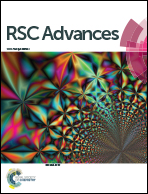The effect of small pyramid texturing on the enhanced passivation and efficiency of single c-Si solar cells
Abstract
In this work, a simple method to form small random pyramid texturing (0.5–2 μm size) is proposed to enhance the surface passivation of commercial p-type Cz-Si wafers. Small pyramid texturing was generated with chemical nano-masking for anisotropic etching. The surface recombination velocity obtained after the passivation of the thermal oxide layer reduced from 65 and 10 cm s−1 for the large pyramids (10–15 μm size) and small pyramid (0.5–2 μm) texturing respectively. The solar cell fabricated with large pyramid texturing resulted in an efficiency of 17.82% with a current density (JSC) of 36.91 mA cm−2, an open circuit voltage (VOC) of 620 mV whereas small pyramid texturing resulted in an efficiency of 18.5% with JSC of 37.6 mA cm−2 and VOC of 628 mV. The low surface recombination velocity increases the VOC by 8 mV. The small pyramid textured wafers are found to enhance the quantum efficiency performance in both short and long wavelength regions.


 Please wait while we load your content...
Please wait while we load your content...